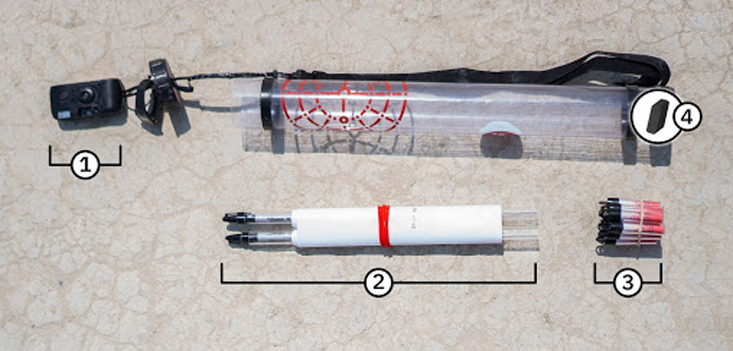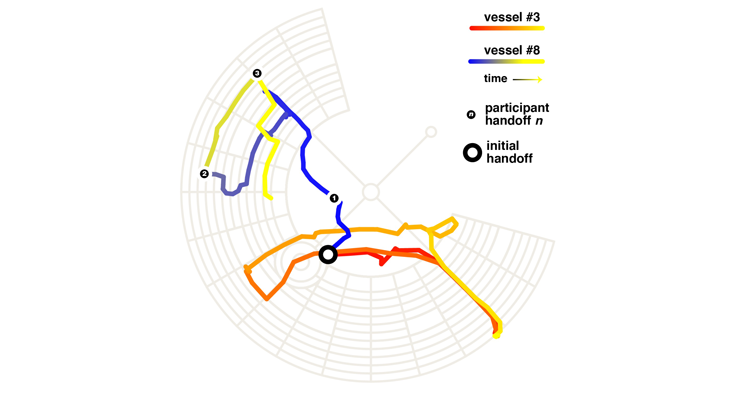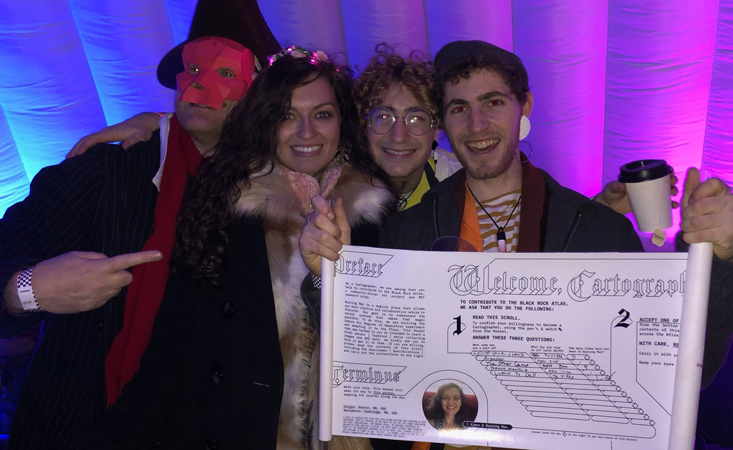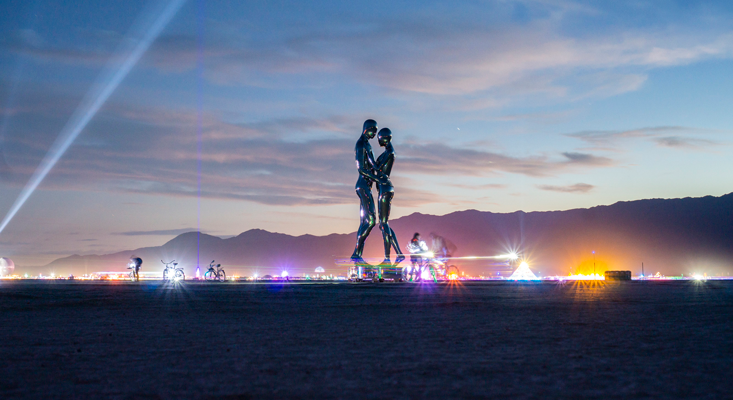Today the alkaline desert is quiet. The roar of techno music and flamethrowers has been replaced with the soft clink of rakes and trash cans. Thousands of people put aside their hangovers to methodically clean the desert. After a dedicated communal cleaning, Burning Man, one of the largest arts events in the world, spanning seven days and involving over 70,000 participants, leaves not a single wrapper on the desert. Among the swarm of salt-crusted denizens of this ephemeral city (known as Burners) is us: a scientist who studies cooperation, an industrial designer, and a Silicon Valley security CEO. Among the dismantled rigs, lifeless pyrotechnics, and bowed heads of Burners absorbed in cleaning, we are here trying to answer a simple question: How, after so many years, could Burning Man throw an event of such chaos, and yet leave the desert without a trace? What leads thousands of people in such an extreme environment to consistently engage in cooperative behavior at a scale seldom seen in society?
To answer that question, we must start our journey at the MIT Media Lab, in an aptly named research group: Scalable Cooperation. This group studies how technologies—social media, the Internet, artificial intelligence—can empower cooperative human networks. The group’s heritage includes the scientists who solved DARPA’s Red Balloon Challenge in 2008, in which the United States government scattered 10 red weather balloons across the continental U.S., and instructed teams of researchers to locate them as fast as possible. The winning MIT team found all 10 balloons in just under nine hours using the virality of social media and an incentive structure that motivated people to recruit their friends. This result was a resounding success for crowdsourcing and the Internet at large, demonstrating that a collective of individuals, connected through technology, could together solve large-scale problems that no individual could solve alone.
Our experiment was a play on the famous Small World Experiment, which led to the phrase, “six degrees of separation.”
This same team, however, struggled with other Internet-based forms for mass cooperation. During the 2011 DARPA Shredder Challenge, which involved recruiting and coordinating individuals on the Internet to collectively recombine shredded documents, people took advantage of the trust necessary for large-scale collaboration. Adversarial participants from the other teams, who felt the crowdsourcing essentially amounted to “cheating,” posed as volunteers and sabotaged the crowdsourcing effort,1 rendering cooperation impossible. Fast-forward five years, to the 2016 presidential election, and we see how this antagonism can be a serious problem for genuine collective action. Bad actors proliferated misinformation at such a rate that The New York Times declared, “The Internet trolls have won. Sorry, there’s not much you can do.”
So when do networks enable cooperation to thrive? And when do they hinder it? A vast body of work from across anthropology, psychology, and sociology has explored the conditions under which cooperation—the propensity for individuals to pay a personal cost for the benefit of the whole—operates. Michael Tomasello’s book Why We Cooperate recounts numerous experiments with children and apes to argue that cooperation is an innate trait that has evolved on an evolutionary timescale. While he acknowledges that genetics impacts cooperation, he also stresses that the environments in which we grow up fundamentally shape our ability to cooperate. Nature and nurture. A defining characteristic of our species is that we often operate within complex social institutions that both require and facilitate cooperative behavior.

Over the years, scientists have examined how these social networks can be configured to maximize cooperation. In a 2011 study, David Rand, Samuel Arbesman, and Nicholas Christakis show that many types of social networks cause cooperation to devolve.2 In particular, they show that networks where people cannot update their connections based on interactions, or when these updates are random, cooperation decays over time. But they also demonstrate that in networks where individuals can easily change who they interact with, cooperation is stable. This suggests that how we design our social networks—our communities and our institutions—plays a critical role in determining the prevalence of cooperation.
But can we see the same effects on cooperation on the networks of society outside of the laboratory? Perhaps the most influential study that explores this question is Stanley Milgram’s Small World Experiment, which sent hundreds of envelopes on journeys across the United States. Milgram was fascinated by the paths that information takes through a community and what they can tell us about the structure of social networks.3 Milgram sent letters to random individuals in the U.S.—each containing information about a final target person, and instructions to pass the letter along to the friend who would get it closer to the target. Through this, he measured the path length between individuals and demonstrated that we live in a “small world,” where a surprisingly small number of friends connect any two people (commonly known as six degrees of separation). But there was one significant flaw in Milgram’s and similar experiments: Only 19 percent of the letters yielded successful chains. In digital replications of his experiment, that number dropped to as low as 1.5 percent. In all these experiments, getting people to participate was difficult. Because people are busy and engaged in their usual environments, they had little incentive to help out.
Now let’s return to our team in the desert. To explore how and when cooperation can thrive in society, we decided to examine a different, extreme environment known for its ability to foster cooperation at a large scale: Burning Man. A community event that takes place once a year in the Black Rock Desert of Nevada, Burning Man has been characterized by some as little more than a hedonistic playground for dusty hippies and Silicon Valley’s elite. Indeed, Burning Man embodies anarchy. But embedded in its chaos exists a sophisticated machinery for community organization, local governance, and participatory action. A central part of this organization is the Burning Man 10 Principles, which serve as the ideological blueprint for the entire event. The 10 Principles contain ideas such as gifting—which encourages people to share with others without any explicit compensation and participation—which invites any person to contribute to collective action. We hypothesized that these principles create an environment where cooperation emerges in ways unseen in the world of Milgram and laboratory studies.
Serendipity struck once again in Rhode Island. “Wait, I think I’m part of this project!” a woman told us.
Our experiment, incubated in Scalable Cooperation in collaboration with computer and network scientists, was a play on the Small World Experiment. We designed it with the same structure of Milgram’s original 1962 study, routing information through Burning Man’s social network with a series of parcels. These parcels, which we named “Vessels” (because everything at Burning Man can and should have a vaguely ritualistic name), were handed out on the first day of Burning Man 2018, containing information about a particular individual at Burning Man. The clearly stated goal of the vessel was to end up in the possession of this individual, so we refer to them as the Terminus. From hand-off to hand-off, these Vessels would collect a variety of information, stories, and data about their journey. We hoped these journeys would allow us to quantitatively map the connectivity of the Burning Man community and qualitatively understand how people engage with Burning Man culture. We hoped not only to count the number of hops of each successful chain, and compare that measure of social connectivity with Milgram’s six degrees of separation, but also to see what cultural, geographic, or attitudinal factors affect success rates. These are not questions that can be probed by scientific methods alone, so we enlisted the input of designers and artists in order to better explore the subjectivity of Burning Man’s magic.
But what should the Vessels look like? We spent the summer leading up to the event talking to Burners in order to find out. We gleaned as much information as we could about the aspects of Burning Man that enable cooperation and creativity. For example, we learned that art at Burning Man is not passively observed like in a museum, but rather invites active interaction such as climbing, touching, or drawing. Often, this relationship is generative, taking on new interactions beyond the original intent of the artist. To capitalize on this, the final contents of each Vessel contained a disposable camera, a scroll, gift pendants, and a GPS tracker. These objects created a ritual of gift exchange and creative user participation, while providing incentives to keep the Vessels moving. The camera allowed each participant to contribute their experience to the project, while generating a visual record of each Vessel’s journey. The pendants contained a web URL that allowed participants to access the project in its final form and provide valuable feedback on their experience. The GPS unit allowed us to see how the Vessels traveled across the desert, and to build a data-driven map of mobility.

The Vessel also contained a scroll resembling a Hebrew Torah with instructions for the experiment, the information for finding the Terminus, and the necessary context and disclosure. Based on our research into the Burning Man Glossary, we carefully mediated the writing style of the text, crafting a vernacular of ritual and removing words that were inaccessible or that seemed overly “default”—Burning Man’s term for the outside world.
In order to select individuals as the destination for each Vessel, we collaborated with the Burning Man Journal on a broadcast that asked the Burning Man community to sign up for participation. We expected only a handful of people to be willing to help with the project. To our surprise, we were flooded with volunteers and offers of support, from people all over the world. From a single blog post, over 350 people offered to become a Terminus, giving us a diverse and representative subject pool. In their correspondence to us, Burners said things like: “Super excited for your project! I did my Ph.D. on network community structure. Would be thrilled to help assemble data and analyze.” and “I’m excited to be involved with this project! Let’s make it happen!”
From that pool of 361 volunteers, we carefully choose our 15 final Terminii to mirror the demographic distributions of the larger Burning Man population on features such as age, origin, experience, and gender. Based on these criteria, we randomly selected 15 people in order to not introduce experimenter bias into the methods (for our full method, please see our research paper).4
For each Terminus, their corresponding scroll included their name (birth name and “Playa” name), their picture, their city of origin and their home city, and a brief sentence that described their interests. With the details provided, we were careful to share enough information so that the Vessel could be routed to someone closer, but not too much information (say, the Terminii’s camp location) that would make social search trivial. One Terminus was a blue-bearded Burning Man Ranger with a flamethrower who drove around on a Cookie Monster art car. Another was an entomologist who wore wings and antennae. A third was a performer in his 70s who danced to EDM through the night.
On Aug. 27, 2018, we trekked into the desert in search of cooperation. Burning Man is known for the severe traffic involved with routing tens of thousands of vehicles on a single dirt road. In some cases, it can take eight hours to travel half a mile. But instead of the headache of urban traffic jams, we were greeted with something more akin to a decentralized party. Around us, people shared snacks and sunbathed on roofs—it was generally a good time.

The next morning, we activated the 15 GPS units, epoxied them into the Vessels, and went to Inner Playa—the central hub of Black Rock City—to launch our experiment. Along the way, we passed out pendants to the many curious passersby. We hoped the pendants would help to create a visible community of people associated with the project, building hype and visual presence on the Playa.
We arranged the Vessels to send in a line. In true Burning Man fashion, we loudly made our presence known by heckling passersby. To the folks we assembled, we explained the nature of the experiment and asked them if they would like to contribute. Those who accepted the challenge became the first Cartographers. Over the course of one hour, we handed out all 15 Vessels and returned to camp to celebrate with a bowl of dusty chili.

The scrolls stipulated that the Vessels should be returned to the Burning Man Lost and Found if the Vessel found its way to the Terminus, or if the event ended. After the dust and ash had settled at the end of the Burn, three Vessels found their way back to the Lost and Found and we grabbed them on our way out. We were exhausted from the long week, but excited to analyze the results.
We returned to the MIT Media Lab, and a few days later, strange packages started to arrive. It turns out two more Vessels had been turned into the Burning Man Lost and Found after we had left the Black Rock Desert. These Vessels had been kindly mailed back to us by the Lost and Found staff. After inspecting the five total Vessels, it seemed like our attempt at social search was unsuccessful. We reached out to all 15 Terminii to see if they had received their Vessel, and discovered that none of the Vessels successfully made its way to its Terminus.
We learned, however, that some of the Vessels got very close. One Terminus, a Black Rock Ranger, said that his Vessel found its way to the Ranger headquarters, and that he received a message to pick it up. When he went to retrieve it, however, the Rangers could not find the Vessel. It was eventually found, but not until the he had already left Black Rock City. Another Terminus said that one of his campmates, by the name of Mango, returned to camp with a Vessel for a different Terminus. Mango had been tasked to find someone else, driving a truck repurposed to look like a giant snail. Despite these close calls, it looked like cooperation had failed at Burning Man. The anarchic network of Burning Man was just that: anarchic. If there was a way to efficiently route information through the community, we didn’t find it.

But it all changed one fateful day in October. “You won’t believe this,” an email from Terminus #11, a performer whose real name is Steve, read, “but I finally received the Vessel at Denver’s Decompression last Saturday night! Everything looks to be intact, including the scroll, camera, and GPS unit at the bottom. How can I go about getting it back to you to be included in the Atlas?”
The Decompression event he was referring to is a key part of integrating back into regular life after Burning Man, by convening local burner communities all over the world to “celebrate and cope with re-entry.” The person who had the vessel (and asked to remain anonymous) at the end of Burning Man was also from Denver, and figured while they couldn’t get it to Steve on Playa, they could bring it home and try to find him in Colorado. According to Steve, they reached out to him on Facebook and met up at the Decompression event for the exchange. The scroll explicitly said that the last person with the Vessel should return it to Lost and Found. But the penultimate person in Steve’s successful chain decided to ignore the rules and take the Vessel back to Denver with him, determined to find the Terminus. In the end, not only did the Vessel make its way to its Terminus in four hops, but it also crossed state borders to do so. By the time Steve’s Vessel made it back to us in Cambridge, Massachusetts, all the pendants were gone, but in return it was packed full of Burning Man gifts: stickers, headbands, and dust.
We saw a network that champions cooperative effort and whimsical creativity over efficiency.
Serendipity struck once again when we made our way to the Decompression event in Providence, Rhode Island. We had casually brought with us a couple of the unclaimed Vessels from Lost and Found to the Decompression, just to show people what we had been working on. Lo and behold, we were chatting a friendly woman, explaining the project, when her demeanor quickly changed. “Wait, I think I’m part of this project!” We ourselves had found Terminus #12! And even more incredibly, one of the Vessels we had brought was destined for her. We presented Terminus #12 with her Vessel, and inadvertently become the penultimate links in the six-person chain that got the vessel to its terminus. We, the researchers, had accidentally found Terminus #12, not in the desert, but on the other side of the country, on a cold Providence night.

When we started on this journey, we expected to cleanly measure the efficiency of a social network, just as Milgram had done over 50 years ago. We thought charting the Vessels’ routes would be as straightforward as collecting the Vessels and calculating the rate of return based on the chain lengths. But that’s not what we discovered at Burning Man. We learned something more valuable.
In our commercial society, networks are designed for efficiency and growth. They are configured for optimal routing. Be there on time, don’t wander, profits depend on it. The same is true for what has become of the Internet. Optimists envisioned it as a decentralized network of individuals that could upend the hierarchies of government and corporations. But today dominant sites, built on proprietary algorithms and overrun by advertising, have commodified personal identity and reinforced political echo chambers.
At Burning Man, we got a powerful glimpse of a social network that breaks the chains of techno-bureaucracy. We saw a network that champions cooperative effort and whimsical creativity over efficiency. These values create a unique context where unexpected optimism and serendipity are the norm. Our experiment showed us what people can be when freed from circumscribed networks, and that vision burns bright. We can design social networks—our communities, our institutions, and our communication platforms—to embody the cooperative and optimistic spirit that affirms our humanity. Cooperation doesn’t have to be forced on us, it can come from within us. That’s how a desert is cleaned. And how a Vessel finds its way home.

Ziv Epstein is a Ph.D. student at the MIT Media Lab. Micah Epstein is a designer, systems thinker, and recent graduate of the Rhode Island School Of Design. Christian Almenar is cofounder and CEO of the Silicon Valley-based CyberSecurity company Intrinsic. Manuel Cebrian is a research scientist at the MIT Media Lab and the Center for Humans & Machines at the Max Planck Institute for Human Development.
We would like to thank our collaborators on the project, Matt Groh, Niccolo Pescetelli, Nick Obradovich, Esteban Moro, and Iyad Rahwan, for helping to bring science to the Playa. In particular, Nick and Esteban made crucial contributions to the research design and experimental methods, and Iyad brought the team together and provided intellectual, strategic, and logistical support. We would like to thank Stuart Mangrum and Caveat Magister at the Burning Man Organization for providing institutional resources, and Lauren Carly at the Burning Man Lost and Found. A big thanks to Sway and the rest of the Scutoid family for their kindness and hospitality during the Burn. We would also like to thank bunnie Haung, Sarah Newman, Kim Albrect, Daniel Yudkin, Oren Lederman, Dan Novy, and Jie Qi for invaluable discussion, ideas, and feedback. We would also like to thank Bill Powers, Matthew Eva, Mary Cait Milliff, and Blakeley Hoffman Payne for insightful edits on this article. Finally, we would like to thank the 15 Terminii who participated in the project, and the Burning Man community at large for their support and enthusiasm.
Lead photograph by Micah Epstein.
References
1. Press release. UC San Diego team’s effort in DARPA’s shredder challenge derailed by sabotage. JacobsSchool.ucsd.edu.
2. Rand, D.G., Arbesman, S., & Christakis, N.A. Dynamic social networks promote cooperation in experiments with humans. Proceedings of the National Academy of Sciences 108, 19193-19198 (2011).
3. Milgram, S. The small world probem. Psychology Today 2, 60-67 (1967).
4. Epstein, Z., et al. Towards a new social laboratory: An experimental study of search through community participation at Burning Man. arXiv.org abs/1903.04125 (2019).






























